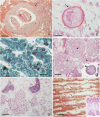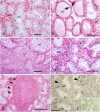Assessment of the Health Status of Mussels Mytilus galloprovincialis Along the Campania Coastal Areas: A Multidisciplinary Approach
- PMID: 29946265
- PMCID: PMC6005891
- DOI: 10.3389/fphys.2018.00683
Assessment of the Health Status of Mussels Mytilus galloprovincialis Along the Campania Coastal Areas: A Multidisciplinary Approach
Abstract
The bivalve Mytilus galloprovincialis has a broad geographic distribution, represent an important species for the ecology of coastal waters, also constituting a major aquaculture species. In the present work, molecular and tissue biomarkers were examined in mussel populations (M. galloprovincialis) located in four different areas of the coastal water of the Campania Region. During an annual life cycle, we analyzed the expression patterns of several genes commonly used to estimate cellular stress response and damage, namely p53, p63, HSP70, MT-10, and MT-20, related tissue lesions (pathogens, inflammations, digestive tubules damage), oxidative stress indicators (H2O2, SOD specific activity) and associated environmental data. The computed Principal Component Analysis showed that the areas were discernible based on the environmental data and biomarker results. About animal health status, mussels from Gulf of Pozzuoli and Naples's harbor did show a thinnest epithelial cell of digestive tubules compared to mussels sampled from other sampling sites; moreover, high prevalence of cases of intersex in three of the examinated areas were observed. The presence of a potential zoonotic pathogen (Nocardia crassostreae) was identified, appearing as an important possible emerging disease. We also reported the OIE notifiable protozoa Marteilia refringens in three areas out of four. The likely impact of both observed pathogens on the mussel health and shellfish aquaculture needs to be urgently addressed. Results are discussed considering animal histopathological health parameters and biological effects.
Keywords: biomarkers; cell damage; environmental stressors; health status; mitochondrial function; mussel.
Figures









Similar articles
-
Assessing the health status of farmed mussels (Mytilus galloprovincialis) through histological, microbiological and biomarker analyses.J Invertebr Pathol. 2018 Mar;153:165-179. doi: 10.1016/j.jip.2018.02.018. Epub 2018 Mar 6. J Invertebr Pathol. 2018. PMID: 29501499
-
Detection and Quantification of Nocardia crassostreae, an Emerging Pathogen, in Mytilus galloprovincialis in the Mediterranean Sea Using Droplet Digital PCR.Pathogens. 2023 Jul 28;12(8):994. doi: 10.3390/pathogens12080994. Pathogens. 2023. PMID: 37623954 Free PMC article.
-
The effects of culture-site, depth, season, and stock source on the prevalence of Marteilia refringens in cultured mussels (Mytilus galloprovincialis Lmk.) from Galicia, Spain.J Parasitol. 1995 Jun;81(3):354-63. J Parasitol. 1995. PMID: 7776120
-
Shellfish and residual chemical contaminants: hazards, monitoring, and health risk assessment along French coasts.Rev Environ Contam Toxicol. 2011;213:55-111. doi: 10.1007/978-1-4419-9860-6_3. Rev Environ Contam Toxicol. 2011. PMID: 21541848 Review.
-
Exploring the immune resilience of Mediterranean mussels: Recent advances and future directions.Fish Shellfish Immunol. 2025 Mar;158:110147. doi: 10.1016/j.fsi.2025.110147. Epub 2025 Jan 19. Fish Shellfish Immunol. 2025. PMID: 39837400 Review.
Cited by
-
Physiological and gene transcription assays to assess responses of mussels to environmental changes.PeerJ. 2019 Oct 4;7:e7800. doi: 10.7717/peerj.7800. eCollection 2019. PeerJ. 2019. PMID: 31592166 Free PMC article.
-
The Mediterranean Mussel (Mytilus galloprovincialis) as Intermediate Host for the Anisakid Sulcascaris sulcata (Nematoda), a Pathogen Parasite of the Mediterranean Loggerhead Turtle (Caretta caretta).Pathogens. 2020 Feb 13;9(2):118. doi: 10.3390/pathogens9020118. Pathogens. 2020. PMID: 32069882 Free PMC article.
-
Risk valuation for E. coli contamination in Campania region shellfish from 2016 to 2021.Heliyon. 2023 Nov 2;9(11):e21716. doi: 10.1016/j.heliyon.2023.e21716. eCollection 2023 Nov. Heliyon. 2023. PMID: 38027549 Free PMC article.
-
Are Marine Heatwaves Responsible for Mortalities of Farmed Mytilus galloprovincialis? A Pathophysiological Analysis of Marteilia Infected Mussels from Thermaikos Gulf, Greece.Animals (Basel). 2022 Oct 17;12(20):2805. doi: 10.3390/ani12202805. Animals (Basel). 2022. PMID: 36290191 Free PMC article.
-
Histopathological and Molecular Study of Pacific Oyster Tissues Provides Insights into V. aestuarianus Infection Related to Oyster Mortality.Pathogens. 2020 Jun 20;9(6):492. doi: 10.3390/pathogens9060492. Pathogens. 2020. PMID: 32575736 Free PMC article.
References
-
- Albanese S., De Vivo B., Lima A., Cicchella D., Civitillo D., Cosenza A. (2010). Geochemical baselines and risk assessment of the Bagnoli brownfield site coastal sea sediments (Naples, Italy). J. Geochem. Explor. 105 19–33. 10.1016/j.gexplo.2010.01.007 - DOI
-
- Altavista P., Belli S., Bianchi F., Binazzi A., Comba P., Del Giudice R., et al. (2004). Cause-specific mortality in an area of Campania with numerous waste disposal sites. Epidemiol. Prev. 28 311–321. - PubMed
LinkOut - more resources
Full Text Sources
Other Literature Sources
Research Materials
Miscellaneous

